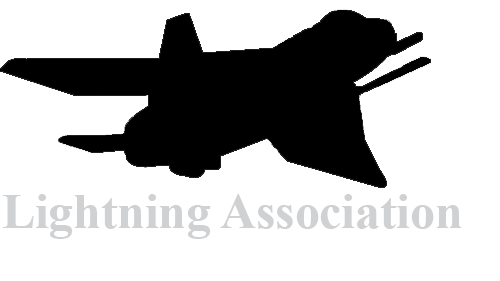XR724 Lightning F.6

English Electric Lightning F.6 XR724 was the first to be retired of the five Lightnings allocated by the MoD to British Aerospace at Warton as chase aircraft in the Tornado Foxhunter radar development trials. Her Fatigue Index (FI) was coming perilously close to zero, and so she was flown to RAF Shawbury for storage while she still had some FI left on the airframe. Once below zero she would not have been able to fly again under any circumstances.
Some of you probably know the story of the two Lightnings allocated to Leuchars and Lossiemouth for Battle Damage Repair (BDR) practice when they were reaching the end of their operational lives. The first was flown to Leuchars and the pilot went back for the second. However, as it was the last flight, he decided to do some interesting aeros on the way but had to put into Leuchars to refuel. Whether this had been planned or whether he'd used more fuel than he intended, I don't know. Anyway, on landing, the engineers checked the G-meter readings and informed the pilot that he'd pulled so many G during the flight that the aircraft was grounded. Even the short remaining flight to Lossiemouth was forbidden.
When XR724 came up for purchase on an MoD tender, the aeroplane had no engines or seat, but had been perfectly preserved in a temperature and humidity-controlled hangar at RAF Shawbury. We did not know about the tender, since MoD Disposals, as it was at that time, did not circulate all interested people with every tender. In consequence, one of our members who did know about it put in a bid, which was successful. We don't think he really expected his bid to be successful, but it was. As those of you who do these things know, you then have 28 days to get your purchase off MoD land or they charge you enormous penalties. However, this fortunately coincided with one of the Lightning Association Rally Open Days at Binbrook, where most of the LA movers and shakers were present, and we took an immediate decision to repurchase it from our member by means of a share scheme. The second important decision of the day was to try, if at all possible, to recover it from Shawbury to Binbrook in an operational state, i.e. without cutting it, but more of that later.
OK, so the situation is that we have bought a Lightning at RAF Shawbury, but we have problems. Number one is that the clock is already running on the 28 days to get her out. Number two is that every other Lightning in operational condition in the UK came with a piloted flight into the airfield of the purchaser's choice as part of the deal. Not ours. Number three is that our Lightning has no engines or ejection seat. Nobody else had these problems. The decision at Binbrook on the day of purchase was that we would try to fly her out. The engineering work would be done by members of the Lightning Association and Barry Pover's Lightning Flying Club, with Barry in charge on the ground at Shawbury reporting to Charles Ross as overall Project Manager. Barry was going to loan us two zero-timed Avon's from his assets and Mick Cameron, who was a senior armourer at Wattisham, was going to rebuild an ejection seat from a bare pan. Charles’s job was to ensure that it all happened and that all the people who would eventually have to be involved, from directors of British Aerospace to the runway sweepers at Binbrook, all did their bit, on time, and all as complete volunteers. It had to cost us virtually nothing, because we had virtually nothing.
At that time, Barry was trying to rebuild XS451 to flying condition and having problems convincing the CAA that he was competent to do so, as the aircraft he had worked on as a CAA certified engineer (Beech King Air etc) were not Mach 2 jets. His Lightning was being recovered from instructional airframe status, whereas ours had been flown into Shawbury from Warton and had simply had the engines and seat removed, remaining since in a climate-controlled hangar. Barry was prepared to put in the time, as if we managed to fly '724 out under his engineering control, it could do nothing but good for his efforts to persuade the CAA to let him fly '451. (Sadly, '451 eventually flew in South Africa as ZU-BEX and was lost with its pilot, Dave Stock, one of the best, while attempting to recover to Bredasdorp AFB during the Overberg Air show after Dave lost control of the flying surfaces due to fire).
Charles’s first task was to secure an extension to the 28 days, as it was going to be impossible to do anything in that time. Apart from installing the engines and seat, we would have to do all the ground functionals, undercarriage retraction on jacks etc. etc. and at this stage we didn't even know if we would be allowed on the base at all, never mind work on the aeroplane. His first letter to the MoD guy in charge of the disposals was not good news. 28 days was 28 days and we had to be out. This would have meant cutting off the wings and fin, ending any chance of flying or even taxiing again.
At this point, he learnt two valuable lessons in aviation. Number one - never give up, and number two - if you can get the person with executive authority on your side, you can achieve virtually anything. So, Charles wrote to the base commander, explained who he was and what he was trying to do. Charles told him about the situation with MoD. He got a letter back saying that as long as he commanded the base we would have as much time as we needed to recover '724 for flight and we would have as much access to the airfield and its facilities as we required. It was a great day and a fantastic example of what enlightened RAF officers can do to maintain public support for the Service in these difficult times.
So, recovery for flight began. Despite RAF help on the ground, the Permit to Fly depended on the CAA and their time even in those days was costed at £150 per man-hour spent considering any project. We didn't have that sort of money, so Barry Pover agreed to cover that if we gave him exclusive control of contact with CAA on our project, as he didn't want the Head of Applications at CAA to be phoned up by a variety of different people all asking the same questions. This seemed reasonable, so we agreed to that if Charles was always kept in the information loop.
It took many months of intensive effort, but eventually the good news was that the engines and seat were installed, and that British Aerospace signed off the airframe and Rolls-Royce signed off the engines as serviceable. The bad news was that the CAA would not issue the Permit to Fly, although Charles had been told by Barry that they would. In consequence, Charles had arranged with the Vulcan boys for XH558 to be up for an air test on the same morning as '724 was supposed to depart Shawbury. Of course, formation flying had to be authorised with the appropriate people, but if two aircraft happened to occupy the same area of sky at the same time by pure coincidence...... It would have been fantastic to have seen the Vulcan and Lightning overfly Binbrook, Scampton and Waddington in succession on the same morning, but it never happened. The CAA had never agreed anything, and the rest of that story is included in past issues of the Lightning Review. If you want to know what happened, read them. It's all in the public domain.
So, back to square one, but remember Charles’s valuable lessons in aviation. He then wrote to Sir Graham Day, then Chairman of British Aerospace, and again explained who he was, what we had done and what had happened to date. Charles asked if there was any mechanism within the Company by which '724 could be recovered to Binbrook. Charles will never forget the two-line letter which he received by return. It read: 'Dear Mr Ross, I have instructed my military aviation division to put themselves at your disposal to recover your Lightning to RAF Binbrook.' Like Winston Churchill at the beginning of WWII, the right man with the necessary vision had been in the right place at the right time. The next day Charles was contacted by senior management at BAe who simply said that Sir Graham had told them to recover our aircraft and what would I like them to do. Another great day and another great decision by a great man.
In the event, on 23rd July 1992, XR724 took off from RAF Shawbury and was flown back to Binbrook by Peter Gordon-Johnson, Deputy Chief Test pilot of BAe and the same pilot who had flown '724 into Shawbury on its previous 'final flight'. At our request, RAF Scampton temporarily reinstalled the RHAG (which had been removed) in case of chute failure and provided a mobile Air Traffic unit and fire and ambulance cover, yet another decision by an enlightened RAF base commander which gained the Service enormous public support and approval.
There's still a great deal of what happened which is confidential and cannot be told, but on a grey day on the Windy Hill, '724 broke cloud to the north and flew down the Binbrook runway at approximately 1340 hrs and, after doing flypasts at Scampton, Waddington, Wattisham and Coningsby, touched down at the spiritual home of the Lightning in front of an enormous crowd and shut down its engines after back-tracking down the runway to taxy back to the ASF pan past the old Bomb Dump and into the 5 Sqn line, where it was received by Phil Wallis, Mick Cameron and Geoff Commins. We had taken a dead shell and returned it to life and to the air, proving that it was possible for a group of professional engineers to come together from their various occupations and prepare an aircraft of this complexity for flight, to the complete satisfaction of the Design Authority and the engine manufacturer. A specially commissioned signed print and a limited edition of photographs were flown in the aircraft on the day, and these are still available to members.
OK, so '724 has flown in and we are in the same position as other groups who got theirs direct, even though it was only after achievements which, we think it is fair to say, many could only have dreamed of. Wrong! We were for a short time, but the ejection seat had to go back and, more importantly, Barry decided he wanted his engines back. That was all fair enough as far as it went, but Barry also decided that he wanted our jet pipes on loan, which he said were now 'matched' to his engines and would make the task of getting his own aeroplane flying much easier. We don't know whether or not that was a fairy story - perhaps some of the engineers out there can tell us - but as he had given us so much help we drew up a proper loan agreement which was signed and witnessed and gave permission for him to take the jet pipes as well.
Unfortunately, and unknown to us at the time, he also asked to borrow, and was given by one of our engineering team, the Form 700, which he said would be good evidence of his competence to place before the CAA. Why a photocopy would not have sufficed we don't know, but as said, it happened without Charles’s knowledge. The jet pipes had been fitted brand new just before '724 left Warton to fly into Shawbury and were without doubt the lowest-houred, documented jet pipes in existence. Once safely back at Exeter, however, Barry then told us that unless we paid his CAA costs for the flight that never happened, we would not get the jet pipes and Form 700 back, and since that was financially impossible, we never did. Those jet pipes went out to South Africa and Barry probably still has the Form 700 to this day. As said about Pover before, all this is fully documented in past issues of the Lightning Review and is all in the public domain.
So, once again we had a dead jet, but only temporarily. Cutting a long and fraught story short, Charles found and purchased a complete ejection seat with my own money, and this was duly installed. He also managed to successfully tender for three air-lifed and documented engines in an MoD disposal sale, and when we got them back to Binbrook, two were installed in '724 and one is still here at Binbrook in its box untouched. We also eventually managed to source the necessary jet pipes, and these were also installed to finally bring '724 back to life. It wasn't easy and it wasn't cheap, but we did it.
For many years after that, the aeroplane was run regularly, and the annual Lightning Rally was held and was the high spot of the year for many members. Unfortunately, since then we have had many problems, not least of which has been the fact that the part of Binbrook where we are has been sold on several times and on each occasion we have had to negotiate the sometimes difficult task of establishing relationships with new owners.
But we now find ourselves in a very good situation with a well-stocked and experienced engineering team plus ‘724 undercover for the first time in many years. The future of ‘724 looks bright!
-

Slide title
© Paul Ridgewell
Button -
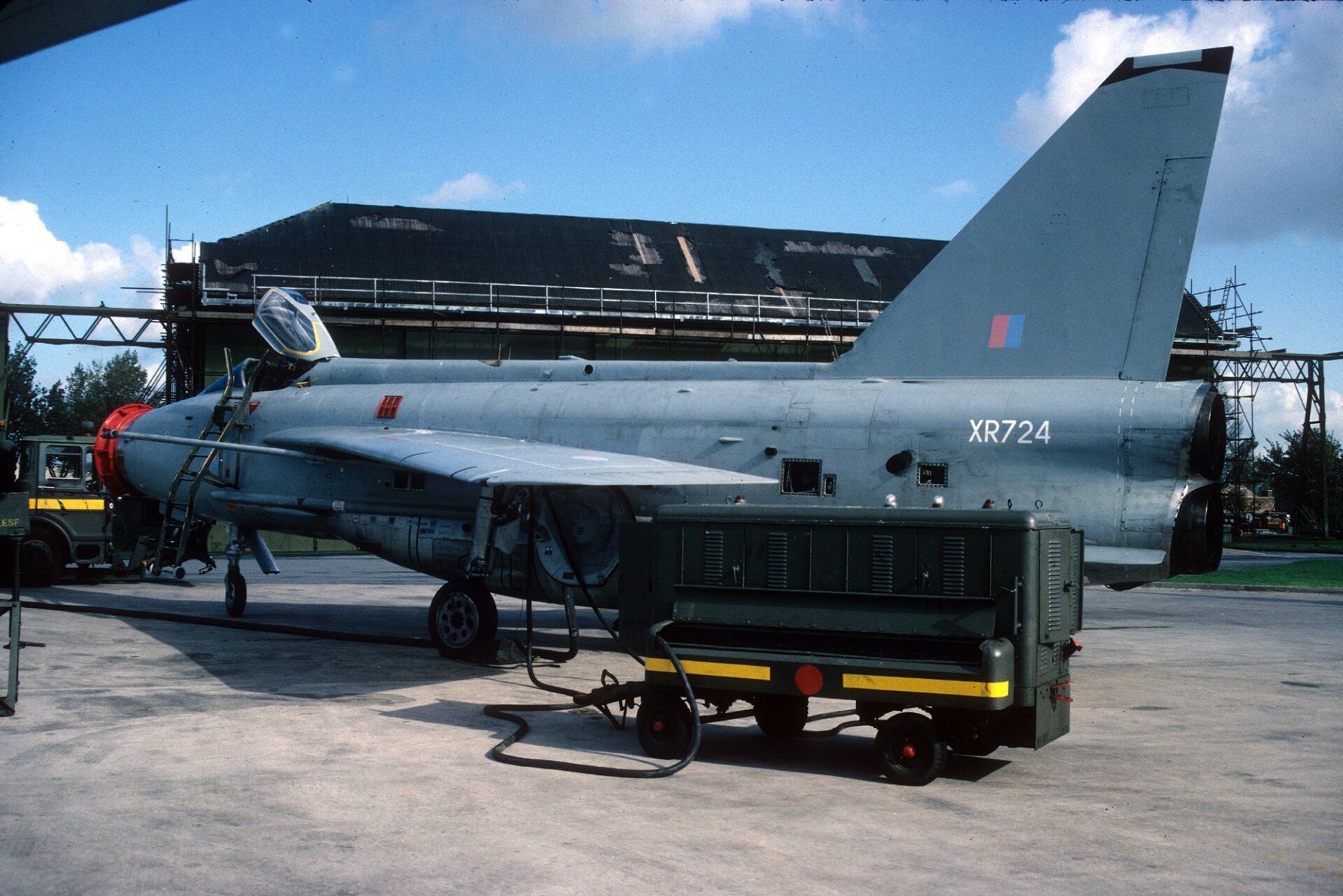
Slide title
© Terry Senior
Button -
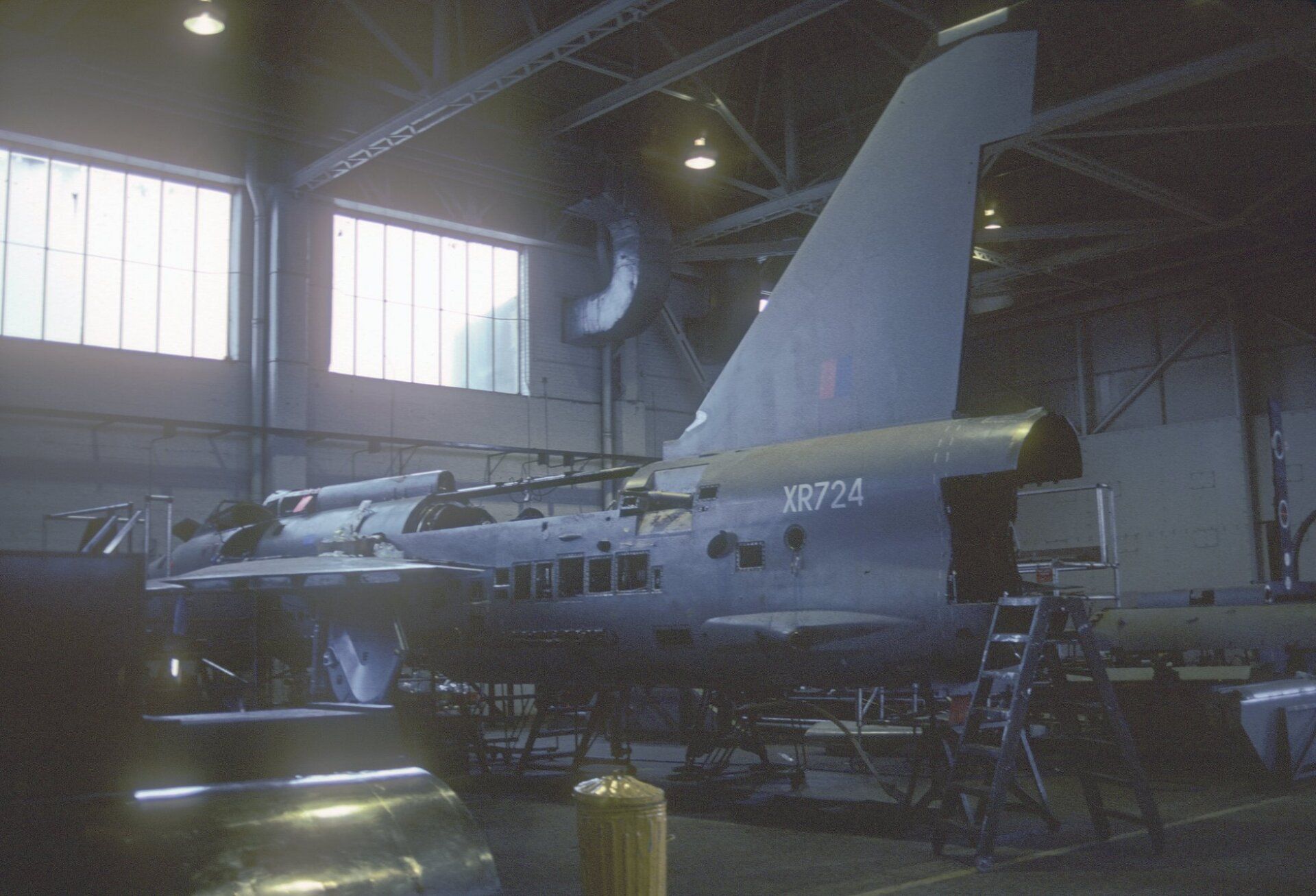
Slide title
© Terry Senior
Button -

Slide title
© Terry Senior
Button -

Slide title
© Terry Senior
Button -

Slide title
© Terry Senior
Button -

Slide title
© Terry Senior
Button -
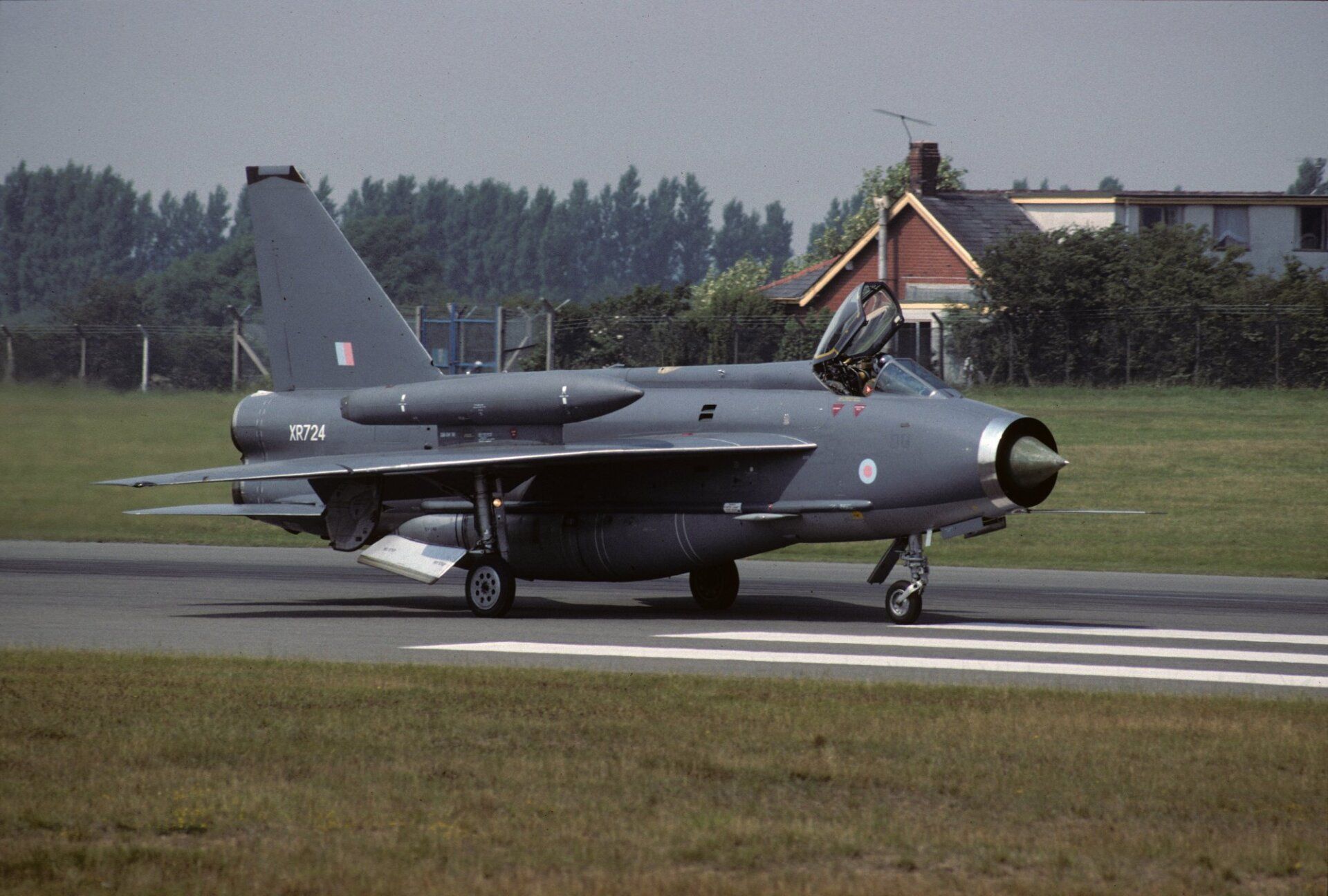
Slide title
© Terry Senior
Button -

Slide title
© John Gilder
Button -

Slide title
© John Gilder
Button -

Slide title
© John GIlder
Button -
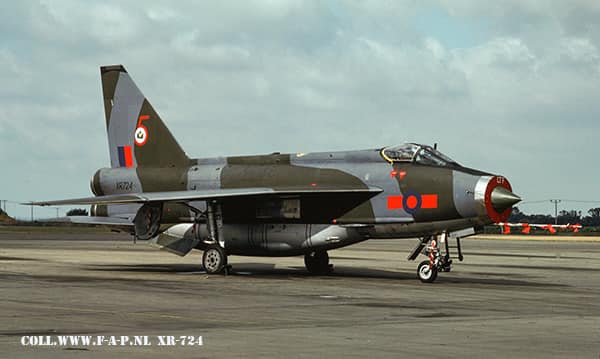
Slide title
© Siete Meeter Collection
Button
XR724 Lightning F.6

English Electric Lightning F.6 XR724 was the first to be retired of the five Lightnings allocated by the MoD to British Aerospace at Warton as chase aircraft in the Tornado Foxhunter radar development trials. Her Fatigue Index (FI) was coming perilously close to zero, and so she was flown to RAF Shawbury for storage while she still had some FI left on the airframe. Once below zero she would not have been able to fly again under any circumstances.
Some of you probably know the story of the two Lightnings allocated to Leuchars and Lossiemouth for Battle Damage Repair (BDR) practice when they were reaching the end of their operational lives. The first was flown to Leuchars and the pilot went back for the second. However, as it was the last flight, he decided to do some interesting aeros on the way but had to put into Leuchars to refuel. Whether this had been planned or whether he'd used more fuel than he intended, I don't know. Anyway, on landing, the engineers checked the G-meter readings and informed the pilot that he'd pulled so many G during the flight that the aircraft was grounded. Even the short remaining flight to Lossiemouth was forbidden.
When XR724 came up for purchase on an MoD tender, the aeroplane had no engines or seat, but had been perfectly preserved in a temperature and humidity-controlled hangar at RAF Shawbury. We did not know about the tender, since MoD Disposals, as it was at that time, did not circulate all interested people with every tender. In consequence, one of our members who did know about it put in a bid, which was successful. We don't think he really expected his bid to be successful, but it was. As those of you who do these things know, you then have 28 days to get your purchase off MoD land or they charge you enormous penalties. However, this fortunately coincided with one of the Lightning Association Rally Open Days at Binbrook, where most of the LA movers and shakers were present, and we took an immediate decision to repurchase it from our member by means of a share scheme. The second important decision of the day was to try, if at all possible, to recover it from Shawbury to Binbrook in an operational state, i.e. without cutting it, but more of that later.
OK, so the situation is that we have bought a Lightning at RAF Shawbury, but we have problems. Number one is that the clock is already running on the 28 days to get her out. Number two is that every other Lightning in operational condition in the UK came with a piloted flight into the airfield of the purchaser's choice as part of the deal. Not ours. Number three is that our Lightning has no engines or ejection seat. Nobody else had these problems. The decision at Binbrook on the day of purchase was that we would try to fly her out. The engineering work would be done by members of the Lightning Association and Barry Pover's Lightning Flying Club, with Barry in charge on the ground at Shawbury reporting to Charles Ross as overall Project Manager. Barry was going to loan us two zero-timed Avon's from his assets and Mick Cameron, who was a senior armourer at Wattisham, was going to rebuild an ejection seat from a bare pan. Charles’s job was to ensure that it all happened and that all the people who would eventually have to be involved, from directors of British Aerospace to the runway sweepers at Binbrook, all did their bit, on time, and all as complete volunteers. It had to cost us virtually nothing, because we had virtually nothing.
At that time, Barry was trying to rebuild XS451 to flying condition and having problems convincing the CAA that he was competent to do so, as the aircraft he had worked on as a CAA certified engineer (Beech King Air etc) were not Mach 2 jets. His Lightning was being recovered from instructional airframe status, whereas ours had been flown into Shawbury from Warton and had simply had the engines and seat removed, remaining since in a climate-controlled hangar. Barry was prepared to put in the time, as if we managed to fly '724 out under his engineering control, it could do nothing but good for his efforts to persuade the CAA to let him fly '451. (Sadly, '451 eventually flew in South Africa as ZU-BEX and was lost with its pilot, Dave Stock, one of the best, while attempting to recover to Bredasdorp AFB during the Overberg Air show after Dave lost control of the flying surfaces due to fire).
Charles’s first task was to secure an extension to the 28 days, as it was going to be impossible to do anything in that time. Apart from installing the engines and seat, we would have to do all the ground functionals, undercarriage retraction on jacks etc. etc. and at this stage we didn't even know if we would be allowed on the base at all, never mind work on the aeroplane. His first letter to the MoD guy in charge of the disposals was not good news. 28 days was 28 days and we had to be out. This would have meant cutting off the wings and fin, ending any chance of flying or even taxiing again.
At this point, he learnt two valuable lessons in aviation. Number one - never give up, and number two - if you can get the person with executive authority on your side, you can achieve virtually anything. So, Charles wrote to the base commander, explained who he was and what he was trying to do. Charles told him about the situation with MoD. He got a letter back saying that as long as he commanded the base we would have as much time as we needed to recover '724 for flight and we would have as much access to the airfield and its facilities as we required. It was a great day and a fantastic example of what enlightened RAF officers can do to maintain public support for the Service in these difficult times.
So, recovery for flight began. Despite RAF help on the ground, the Permit to Fly depended on the CAA and their time even in those days was costed at £150 per man-hour spent considering any project. We didn't have that sort of money, so Barry Pover agreed to cover that if we gave him exclusive control of contact with CAA on our project, as he didn't want the Head of Applications at CAA to be phoned up by a variety of different people all asking the same questions. This seemed reasonable, so we agreed to that if Charles was always kept in the information loop.
It took many months of intensive effort, but eventually the good news was that the engines and seat were installed, and that British Aerospace signed off the airframe and Rolls-Royce signed off the engines as serviceable. The bad news was that the CAA would not issue the Permit to Fly, although Charles had been told by Barry that they would. In consequence, Charles had arranged with the Vulcan boys for XH558 to be up for an air test on the same morning as '724 was supposed to depart Shawbury. Of course, formation flying had to be authorised with the appropriate people, but if two aircraft happened to occupy the same area of sky at the same time by pure coincidence...... It would have been fantastic to have seen the Vulcan and Lightning overfly Binbrook, Scampton and Waddington in succession on the same morning, but it never happened. The CAA had never agreed anything, and the rest of that story is included in past issues of the Lightning Review. If you want to know what happened, read them. It's all in the public domain.
So, back to square one, but remember Charles’s valuable lessons in aviation. He then wrote to Sir Graham Day, then Chairman of British Aerospace, and again explained who he was, what we had done and what had happened to date. Charles asked if there was any mechanism within the Company by which '724 could be recovered to Binbrook. Charles will never forget the two-line letter which he received by return. It read: 'Dear Mr Ross, I have instructed my military aviation division to put themselves at your disposal to recover your Lightning to RAF Binbrook.' Like Winston Churchill at the beginning of WWII, the right man with the necessary vision had been in the right place at the right time. The next day Charles was contacted by senior management at BAe who simply said that Sir Graham had told them to recover our aircraft and what would I like them to do. Another great day and another great decision by a great man.
In the event, on 23rd July 1992, XR724 took off from RAF Shawbury and was flown back to Binbrook by Peter Gordon-Johnson, Deputy Chief Test pilot of BAe and the same pilot who had flown '724 into Shawbury on its previous 'final flight'. At our request, RAF Scampton temporarily reinstalled the RHAG (which had been removed) in case of chute failure and provided a mobile Air Traffic unit and fire and ambulance cover, yet another decision by an enlightened RAF base commander which gained the Service enormous public support and approval.
There's still a great deal of what happened which is confidential and cannot be told, but on a grey day on the Windy Hill, '724 broke cloud to the north and flew down the Binbrook runway at approximately 1340 hrs and, after doing flypasts at Scampton, Waddington, Wattisham and Coningsby, touched down at the spiritual home of the Lightning in front of an enormous crowd and shut down its engines after back-tracking down the runway to taxy back to the ASF pan past the old Bomb Dump and into the 5 Sqn line, where it was received by Phil Wallis, Mick Cameron and Geoff Commins. We had taken a dead shell and returned it to life and to the air, proving that it was possible for a group of professional engineers to come together from their various occupations and prepare an aircraft of this complexity for flight, to the complete satisfaction of the Design Authority and the engine manufacturer. A specially commissioned signed print and a limited edition of photographs were flown in the aircraft on the day, and these are still available to members.
OK, so '724 has flown in and we are in the same position as other groups who got theirs direct, even though it was only after achievements which, we think it is fair to say, many could only have dreamed of. Wrong! We were for a short time, but the ejection seat had to go back and, more importantly, Barry decided he wanted his engines back. That was all fair enough as far as it went, but Barry also decided that he wanted our jet pipes on loan, which he said were now 'matched' to his engines and would make the task of getting his own aeroplane flying much easier. We don't know whether or not that was a fairy story - perhaps some of the engineers out there can tell us - but as he had given us so much help we drew up a proper loan agreement which was signed and witnessed and gave permission for him to take the jet pipes as well.
Unfortunately, and unknown to us at the time, he also asked to borrow, and was given by one of our engineering team, the Form 700, which he said would be good evidence of his competence to place before the CAA. Why a photocopy would not have sufficed we don't know, but as said, it happened without Charles’s knowledge. The jet pipes had been fitted brand new just before '724 left Warton to fly into Shawbury and were without doubt the lowest-houred, documented jet pipes in existence. Once safely back at Exeter, however, Barry then told us that unless we paid his CAA costs for the flight that never happened, we would not get the jet pipes and Form 700 back, and since that was financially impossible, we never did. Those jet pipes went out to South Africa and Barry probably still has the Form 700 to this day. As said about Pover before, all this is fully documented in past issues of the Lightning Review and is all in the public domain.
So, once again we had a dead jet, but only temporarily. Cutting a long and fraught story short, Charles found and purchased a complete ejection seat with my own money, and this was duly installed. He also managed to successfully tender for three air-lifed and documented engines in an MoD disposal sale, and when we got them back to Binbrook, two were installed in '724 and one is still here at Binbrook in its box untouched. We also eventually managed to source the necessary jet pipes, and these were also installed to finally bring '724 back to life. It wasn't easy and it wasn't cheap, but we did it.
For many years after that, the aeroplane was run regularly, and the annual Lightning Rally was held and was the high spot of the year for many members. Unfortunately, since then we have had many problems, not least of which has been the fact that the part of Binbrook where we are has been sold on several times and on each occasion we have had to negotiate the sometimes difficult task of establishing relationships with new owners.
But we now find ourselves in a very good situation with a well-stocked and experienced engineering team plus ‘724 undercover for the first time in many years. The future of ‘724 looks bright!

Slide title
© Paul Ridgewell
Button
Slide title
© Terry Senior
Button
Slide title
© Terry Senior
Button
Slide title
© Terry Senior
Button
Slide title
© Terry Senior
Button
Slide title
© Terry Senior
Button
Slide title
© Terry Senior
Button
Slide title
© Terry Senior
Button
Slide title
© John Gilder
Button
Slide title
© John Gilder
Button
Slide title
© John GIlder
Button
